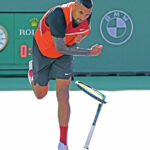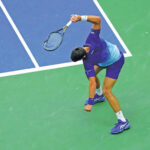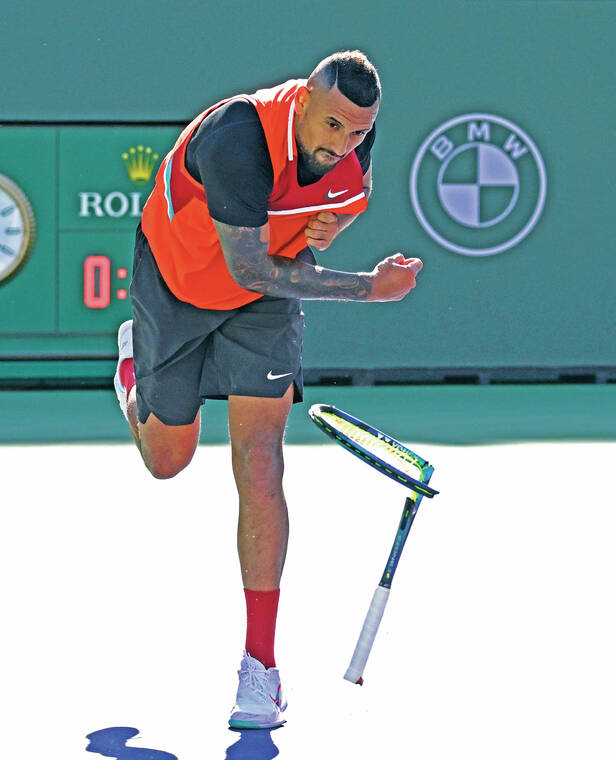How to smash a tennis racket: Rublev, Djokovic, Kyrgios, and more


Andrey Rublev’s second thought was to smash his tennis racket.
His first thought? Protecting the Wimbledon grass.
ADVERTISING
The Russian No 6 seed at SW19 said, “I wouldn’t have done it if I could hit the racket on the ground, but we are not allowed to hit the grass in any way,” in a press conference after his 4-6, 7-5, 2-6, 6-7 defeat to world No 122 Francisco Comesana in the first round of this year’s tournament.
The “it” he was referring to was smashing his tennis racket: not on the court, or a structure, or the fence, but his own leg.
As racket smashes go, there isn’t much smashing of the racket here. Rublev’s knees and thigh will be bruised today, and he drew blood from his leg, but human flesh can’t break a carbon fibre beam.
It might have provided the requisite emotional release, but the self-flagellation — a sad feature of Rublev’s game in 2024 — is more painful to watch than any kind of spectacle. It’s more likely to make a video of tennis players getting angry than any of the myriad compilations of destroyed rackets that grace the internet. There are no twisted strings, no mangled head, no desultory tossing of the useless implement to the side. If developing a metric for smashing tennis rackets, it would score low on style, control, and damage, but high on aggression. Thank you to the British TV series Robot Wars for these categories.
This is the art and science of the racket smash, the tennis staple that brings code violations and fines as much as spectacles for fans and relief for players.
The history of the racket smash is probably as long as that of tennis, but a Pittsburgh Post Gazette report from 66 years ago describes Australia’s Mervyn Rose as a “racket buster” for smashing a couple at the Australian National Tennis Championships in 1958, a decade before the start of the Open Era. Players of all kinds of temperaments, skill levels and gamestyles have done it, do it, and will do it in the future — and there are methods to the madness that takes over a tennis player in the throes of frustration.
Rublev is not the first player to use his body as a highly inefficient smashing post. Mikhail Youzhny, the Russian who reached the quarterfinals of all four Grand Slam tournaments, wrote himself into tennis lore in 2008 by hammering his racket into his own forehead after missing a relatively easy return down 4-5 against Nicolas Almagro of Spain in Miami. Something inside him had cracked, but thankfully neither skull nor racket did the same, and he actually won the match from that point — after he’d cleaned up the blood.
This mode of destruction is an outlier, and not just for its bodily harm. It doesn’t do a very good job of smashing the racket; it’s disturbing, and has a terrible opportunity cost ratio for causing injury to one’s self. It’s in the same league as the frustrated kick out or lash out at a wall that results in a broken hand or foot, as Frenchman Arthur Rinderknech experienced at his home Grand Slam tournament this year. Up two sets to one but down 0-2 in the fourth against Tomas Martin Etcheverry, he kicked an advertising hoarding in anger while still in a position to win. He injured his toe and had to retire.
The stock smash — deployed by Roger Federer and Novak Djokovic, Serena Williams and Victoria Azarenka; inveterate smashers Marcos Baghdatis, Benoit Paire, John McEnroe, and Nick Kyrgios, and the masters of the art, Marat Safin and Goran Ivanisevic — relies on that other intrinsic part of tennis machinery: the court. Dashing a graphite frame into the blue acrylic of the U.S. Open and Australian Open, or the brick red terre battue of the French, is the inverse of Rublev’s self-flagellation: it mangles the racket efficiently, does significant damage, and is somewhat controlled (as the player does not let go.) That won’t stop a code violation for racket abuse, but it prevents some of the less intended consequences of more stylish methods.
Among the elite players of the last two decades, Rafael Nadal and Venus Williams stand out for their complete aversion to damaging rackets. Nadal so much so that when Argentinian Gaston Gaudio claimed that the Spaniard broke seven after a defeat in 2005, Nadal accused him of lying. Williams, for her part, takes the view that smashing a racket signals to the opponent that they have a player on strings. Speaking in an interview with her then-coach Eric Hechtman in 2022, Williams said: “I love to see someone smash their racket. Especially against me.
“It’s like, ‘Oh, go ahead, come undone, just unravel’, and it’s like this is all my doing and I’m the puppet master. Dance! Like I’m Geppetto,” she said, referring to the creator of Pinocchio.
She would certainly have liked to face Safin and Ivanisevic. The latter broke so many rackets during a match in 2000 that he had none left and had to retire; Safin became synonymous with the practice, claiming in 2020 that he broke 1,055 rackets in his career.
Wimbledon doesn’t allow the would-be destroyer to employ any ground force. The threshold for a code violation on the grass is significantly lower, as Mirra Andreeva found out to her cost in 2023, when a very soft smash — or a heavy accidental drop, depending on who you ask — earned her a point penalty in the dying throes of her match with Madison Keys.
Its springiness also lends added risk to the close and more dangerous cousin of the racket smash: the racket-smash-throw, which is a liability on any surface. When a player fully lets go of their racket and hurls it to the floor, the frame can bounce up and go just about anywhere. Kyrgios pinged one into the crowd at Wimbledon in 2017 and was duly given a code violation; Irina Camelia-Begu brought a fan to tears at the French Open when she threw her own and it ricocheted into the stands. Players are at risk of the ultimate price of racket abuse — disqualification — when their actions endanger a spectator or other person on court, but players that endanger themselves, Rublev chief among them, are rarely given warnings.
More frustratingly, the penalties for racket abuse are outcome-weighted, even though the risk of throwing a racket in anger does not change according to whether or not it hits somebody. Kyrgios received a $20,000 fine at Indian Wells in 2022 for nearly hitting a ballkid with a bounce throw, but could easily have been defaulted. The same is true of ball abuse, when a fuzzy yellow thing volleyed at high speed into a wall of spectators has no rhyme or reason as to whether it harmlessly thuds into a wall or leaves a fan with a nasty bruise.
Players will still find ways to break things. To get around the grass edict, they find whatever solid surface they can find against which to exorcise their anger. In last year’s Wimbledon final against Carlos Alcaraz, Novak Djokovic disposed of his preferred whack-it-on-the-ground for wrap-it-around-the-net-post, tossing the frame to the side. Stan Wawrinka did what Rublev could not and broke a racket around his own knee on the lawns of Queen’s, while Mikael Ymer disturbingly hammered the umpire’s chair so hard that he broke a hole in it in Lyon. Others will simply do their smashing in private, or so they think — Aryna Sabalenka was caught putting frame to floor after losing the U.S. Open to Coco Gauff in 2023 by a video whose release was contentious.
After explaining the method in his smash, Rublev went on to explain the madness.
“I don’t know why I did that at that moment, I couldn’t stand it anymore, I needed to let my emotions out,” he said.
While it’s disquieting to watch elite athletes go through such torment — or in other cases, display fits of anger that sadly can betray their truer natures — the racket smash is also one of the more relatable parts of a sport whose highest echelons are completely off limits






